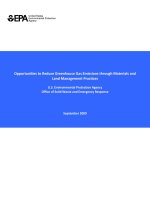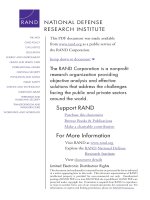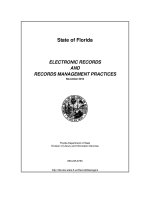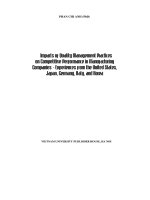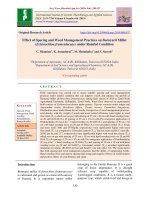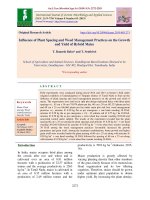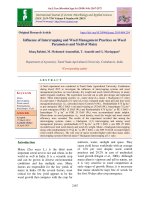Effect of planting density and nutrient management practices on the growth parameters of maize hybrids under temperate conditions of Kashmir
Bạn đang xem bản rút gọn của tài liệu. Xem và tải ngay bản đầy đủ của tài liệu tại đây (199.37 KB, 9 trang )
Int.J.Curr.Microbiol.App.Sci (2019) 8(1): 2317-2325
International Journal of Current Microbiology and Applied Sciences
ISSN: 2319-7706 Volume 8 Number 01 (2019)
Journal homepage:
Original Research Article
/>
Effect of Planting Density and Nutrient Management Practices
on the Growth Parameters of Maize Hybrids under
Temperate Conditions of Kashmir
Ayman1*, B.A. Alie2, Shayan1, Saima3 and Jahangeer A. Baba4
1
Division of Agronomy, FOA/ RRS, Wadura, India
Agronomy, Saffron research station, Konnibal, Pampore, India
3
Division of Basic Sciences & Humanities, FOA /RRS, Wadura, India
4
KVK/ETC, Malangpora, Pulwama, India
Sher-e-Kashmir University of Agricultural Sciences and Technology of Kashmir, India
2
*Corresponding author
ABSTRACT
Keywords
Maize hybrids,
planting density,
Site Specific
Nutrient
Management
(SSNM), Bio-605
Article Info
Accepted:
15 December 2018
Available Online:
10 January 2019
The present piece of research work was carried out at the field of Dryland (Karewa)
Agricultural Research Station, Sher-e-Kashmir University of Agricultural Sciences and
Technology of Kashmir during kharif 2017 to determine the effect of planting density and
nutrient management practices on the performance of maize hybrids. The experiment
comprised of three factors with two maize hybrids viz. Kanchan-101 and Bio-605 as mainplot treatments and two plant geometries viz. 60×20 cm (83,000 plants ha -1), 60×15 cm
(1,11,111 plants ha-1) and three nutrient management practices viz. RDF (Recommended
Dose of Fertilizers), SSNM (Site Specific Nutrient Management) and FP (Farmers
Practice) as sub-plot treatments replicated thrice The results of the experiment revealed
that highest plant height, leaf area index was found higher with plant population of 1,
11,111 plants ha-1 However, highest functional leaves plant-1 was found higher with plant
population of 83,000 plants ha-1. The results showed that balanced fertilization of maize
crop involving nutrient combinations of N, P and K applied as per Site Specific Nutrient
Management (SSNM) recommendation most effectively enhanced growth parameters viz.,
plant height, functional leaves, chlorophyll content and leaf area index. From present study
it can be concluded that maize hybrid Bio-605 under 60×20 cm spacing (83,000 plants
ha-1) with Site Specific Nutrient Management (SSNM) found better suited for temperate
conditions of Kashmir as it gave the higher gross profit (164770 ha-1), net return (112132
ha-1) and B C ratio (2.13).
Introduction
Among cereals, maize (Zea mays L.) ranks
first in total world production and it is staple
food in many countries, particularly in the
tropics and sub-tropics. Globally maize is
cultivated over an area of 179 million ha with
a production and productivity of 967 million
tonnes and 5.7 t ha-1, respectively (Special
maize report 2016). In India maize is
2317
Int.J.Curr.Microbiol.App.Sci (2019) 8(1): 2317-2325
contributing around 24 per cent of total cereal
production (Singh et al., 2011). In India it is
cultivated over an area of 9.9 million ha with
26.3 million tonnes production having an
average productivity of 2.6 t ha-1 (Economic
survey, 2017-18).
In the State of Jammu and Kashmir maize is
cultivated over an area of around 3.1 lakh
hectares with the production of 52.7 lakh
quintals
and
productivity
of 1.7 t ha-1 (Anonymous, 2015). It is the
second important crop after rice in the state
and is a staple food of tribal such as Gujar and
Bakarwall (nomadic race). Maize is generally
grown under rain fed conditions and on
marginal lands particularly in hilly terrains of
the Kashmir valley invariably as mixed crop
with pulses (Pole type beans).
Optimum plant population is one of the
important factors for higher productivity, by
virtue of which there is efficient utilization of
underground resources and also harvesting
maximum solar radiation which in turn results
in better photosynthesis (Monneveux et al.,
2005). An optimum plant population for
maximum economic yield exists for all crop
species and varies with cultivar and
environment (Bruns and Abbas, 2005).
Modern maize hybrids tolerate higher plant
densities than hybrids used in past and the use
of narrow rows has greater potential to
enhance grain yield at crowded stands
(Sangoi et al., 2002). New generation of
maize cultivars are characterized by a better
ability of plant to be grown in denser stand as
they were selected under such conditions
(Peykarestan and Seify, 2012). Thus, there is
a need to work out optimum plant population
of hybrids by adjusting inter row spacing
under prevailing agro-climatic conditions.
In order to achieve higher cob yield,
maintenance of stand density is the most
important factor. A spatial arrangement of
plant governs the shape and size of the leaf
area plant-1, which in turn influences efficient
interception
of
radiant
energy and
proliferation and growth of shoots and their
activity. Maximum yield can be expected only
when plant population allows individual
plants to achieve their maximum inherent
potential (Aravinth et al., 2011). Maize is
categorized as a very exhaustive crop because
of its extremely high demand for the nutrients
specially nitrogen, phosphorus and potassium
from the soil. Nitrogen is an essential
component of amino acids, which are the
building blocks of proteins and is also a part
of the DNA molecule, so it plays a very
important role in cell division and
reproduction. The chlorophyll molecule also
contains nitrogen. Nitrogen deficiency most
often results in slow and stunted growth along
with chlorosis. Most of the nitrogen taken up
by plants from the soil is in the forms of
NO3ˉ. Amino acids and proteins can only be
built from NH4+ so NO3ˉ has to be reduced
with split application of ammonical form of
nitrogen. Nitrogen is usually applied in splits
in the field to avoid various nitrogen losses.
Split application facilitates the crop N
requirements at the time of need of the crop.
Blanket
as
well
as
predetermined
recommended application of fertilizers by
most of the farmers in the zone irrespective of
soil, varieties, climate and farming situation
not only wastes fertilizer resources but also
fails to increase productivity substantially as
the recommendations are either over
estimated or under estimated due to diverse
heterogeneous nature of soil. Such
recommendations assume that the need of
maize crop for nutrients is constant over time
and over large areas. Hence there is an urgent
need to identify the recent nutrient
management approaches, which can increase
nutrient use efficiency from view point of
fertilizer costs and environmental concerns as
well as productivity of crops on sustainable
2318
Int.J.Curr.Microbiol.App.Sci (2019) 8(1): 2317-2325
basis. Productivity of maize is also limited by
low fertilizer efficiency, inadequacy in
existing fertilizer recommendation and
ignorance of nutrient balance and hence,
serious constraint in maize production.
Nutrient management practices (sub-plot)
The novel approach of site specific nutrient
management (SSNM) involves science based
principles for guiding the judicious and
efficient application of fertilizer as and when
needed by crop. The nutrient expert for maize
is a new computer- based decision support
tool developed to assist local experts to
quickly formulate fertilizer guidelines for
maize fields on the principles of Site-Specific
Nutrient management (SSNM). There exists a
significant opportunity to increase fertilizer
efficiency and productivity of maize by
adopting nutrient expert-based field specific
fertilizer recommendations (Satyanarayana et
al., 2013).
Other experimental details
Materials and Methods
A field experiment was conducted at Dryland
(Karewa) Agricultural Research Station,
Sher-e-Kashmir University of Agricultural
Sciences and Technology of Kashmir during
kharif 2017. The site is situated between
34.60N and 74.50E at an altitude of 1580
above mean sea level. The experiment was
laid in split plot design with three replications
which consisted of twelve treatments.
Treatment details
Maize hybrids (main plot)
Kanchan 101:(H1)
Bio 605
:(H2)
(83000 plants ha-1)
(111111 plants ha-1)
Design: Split plot
Replications: 03
No. of Treatment combinations: 12
Season: Kharif, 2017
Total no. of Plots: 36
Plot size: 15 m2
Fertilizer application
Fertilizer application was made as per the
treatment. Full dose of phosphorus and
potassium, zinc and half dose of nitrogen
were applied at the time of sowing by drilling
fertilizer in crop rows about 4-5 cm below the
seeds. The remaining nitrogen was given at
knee high stage as top dressing. FYM was
also applied.
Seed and sowing
Maize hybrids (Kanchan-101and Bio-605)
were sown at the seed rate 20 kg ha-1 on 20th
May, 2017.
Furrows were opened at 60 cm×20 cm and 60
cm×15 cm apart respectively as per the
treatment combination and seeds were placed
at a depth of 3-4 cm in the furrows already
opened for fertilizer application.
Irrigation
Plant density (sub-plot)
60cm x 20cm
60cm x 15cm
Recommended Dose of Fertilizer: (N1)
Site Specific Nutrient Management: (N2)
Farmer’s Practice: (N3)
: (D1)
: (D2)
Irrigation was given to the crop as and when
required depending upon the moisture
availability in the soil. Great care was taken to
ensure the moisture availability in the soil
throughout crop growth period.
2319
Int.J.Curr.Microbiol.App.Sci (2019) 8(1): 2317-2325
Weed management
In order to minimize weed competition, preemergence application of Atrazine (1 kg a.i in
1000 litre of water) followed by one hoeing
and earthing up at 25 DAS was carried out.
Thinning
In order to maintain plant to plant distance of
20 cm and 15 cm desired plant population as
per treatment, thinning was done 15 days after
sowing.
Plant protection measures
Chlorpyrifos was applied @ 20 kg ha-1.
Observations recorded
For recording data, five plants were randomly
selected from the penultimate rows, tagged
from every plot of each replication and used
for recording of various characteristics of
crops at different stages of maize growth.
The average for every parameter was
calculated and recorded after prescribed
intervals. Various growth parameters viz.,
plant height; numbers of functional leaves per
plant, leaf area index of maize were evaluated
at 30 days interval.
Statistical analysis
All the data were subjected to statistical
analysis by adopting appropriate method of
analysis of variance as described by Cochran
and Cox (1967). Wherever the F value was
found significant at 5 per cent level of
probability, the critical difference (CD) value
were computed for comparing treatment
means.
Results and Discussion
The data on plant height of maize plant as
influenced by maize hybrids, planting
densities and nutrient management practices
were recorded at 30 day interval and
statistically analyzed data observed during the
course of investigation have been presented in
Table 1. Plant height is an important growth
parameter to study the accumulation of dry
matter by the plant and is very important to
examine the overall canopy architecture of the
plant and also regulate the orientation of the
leaves that further govern the photosynthetic
efficiency of a plant to utilize the natural
resources. The data showed that the plant
population 1, 11,111 plants ha-1 recorded
significant and consistent increase in plant
height at all the stages of growth as compared
to 83,000 plants ha-1. Also that plant height
recorded under application of SSNM was
significantly superior over RDF and FP. The
increased plant populations intensified
interplant competition for light and stimulate
apical dominance and lengthening internodes.
Accordingly Plant height is greater under high
density (Mandić 2011). Under the present
investigation, profound effect of balanced and
optimum increased fertilization on various
growth parameters of the crop appears to help
in enrichment of soil with this nutrient status,
resulted in better availability of nutrients for
growth and development of plant height at
early stage. Thus better nutritional
environment in plants under the influence of
managed fertilization based on site specific
nutrient management seems to have promoted
height of plants and growth of individual leaf
by way of active cell division, elongation and
even improved chlorophyll synthesis. The
larger canopy development and plant height
under the application of optimum dose of
fertilizer might have increased interception,
absorption and utilization of radiant energy,
photosynthesis.
The data on leaf area index of maize plant as
influenced by maize hybrids, planting
densities and nutrient management practices
were recorded at 30 day interval and
statistically analyzed data observed during the
2320
Int.J.Curr.Microbiol.App.Sci (2019) 8(1): 2317-2325
course of investigation have been presented in
Table 1. Leaf area index was not significantly
influenced by plant population at knee high
stage, however highest leaf area index was
recorded under 1, 11,111 plants ha-1 at
tasseling and maturity. Also, SSNM recorded
highest LAI at knee high, tasseling and at
maturity over RDF and FP and similarly RDF
also recorded higher LAI at knee high,
tasseling and at maturity over FP. Highest
physiological growth indices are achieved
under
high
plant
density,
because
photosynthesis increases by development of
leaf area. In our research, the increase in LAI
explains the general crop trends that
increasing plant density increases leaf area
index on account of more area occupied by
green canopy of plants per unit area. Previous
research findings also indicated that in high
maize density, leaf area index, total dry
weight increased than low maize density
throughout crop growth season (Abuzar et
al.,2011, Bhatt et al., 2012, Thakur et al.,
2015). N fertilizer can increase maize growth
rate by promoting the leaf area index and the
photosynthetic source and sink (Uhart and
Andrade, 1995).
The data on functional leaves plant-1 of maize
plant as influenced by maize hybrids, planting
densities and nutrient management practices
were recorded at 30 day interval and
statistically analyzed data observed during the
course of investigation have been presented in
Table 1. No. of functional leaves plant-1 at 60,
90 and 120 DAS were found significantly
higher in plant population 83,000 plants ha-1
by 16.78, 6.75 and 13.0 per cent, respectively
over 1,11,111 plants ha-1. However, at 30
DAS it was found non-significant. Also No.
of functional leaves plant-1 at 60, 90 and 120
DAS were found significantly higher in
SSNM over RDF and FP. However, at 30
DAS it was found non-significant.
Table.1 Effect of maize hybrids, plant geometry and nutrient management practices on number
of functional leaves plant-1 at 30 days interval
Treatments
30 DAS
60 DAS
90 DAS
120 DAS
S.E (m)±
CD (P≤0.05)
6.02
6.20
0.10
NS
9.10
10.01
0.16
NS
12.92
13.42
0.22
NS
10.97
11.63
0.12
NS
6.27
6.11
0.13
NS
10.30
8.82
0.08
0.33
13.60
12.74
0.17
0.68
11.99
10.61
0.34
1.35
6.15
6.38
9.88
11.05
13.27
14.48
11.18
13.30
6.03
0.23
NS
7.75
0.22
0.65
11.77
0.24
0.72
9.42
0.29
0.88
Hybrid
Kanchan-101
Bio-605
Plant density
60×20cm (83000 plants ha-1)
60×15cm (111111 plants ha-1)
S.E (m)±
CD (P≤0.05)
Nutrient Management Practices
Recommended Dose of Fertilizer (RDF)
Site Specific Nutrient Management
(SSNM)
Farmers Practice (FP)
S.E (m)±
CD (P≤0.05)
2321
Int.J.Curr.Microbiol.App.Sci (2019) 8(1): 2317-2325
Table.2 Effect of maize hybrids, plant geometry and nutrient management practices on
chlorophyll index (Chlorophyll meter readings) at different phenological stages
Treatments
Knee high
Tasseling
At Harvest
S.E (m)±
CD (P≤0.05)
31.21
32.36
0.58
NS
44.47
46.49
0.75
NS
25.59
26.63
0.45
NS
32.10
31.47
0.31
NS
46.02
44.95
0.57
NS
26.37
25.85
0.51
NS
31.65
34.04
29.67
0.69
2.05
45.29
49.72
41.44
0.66
1.99
25.46
28.04
24.83
0.57
1.72
Hybrid
Kanchan-101
Bio-605
Plant density
60×20cm (83000 plants ha-1)
60×15cm (111111 plants ha-1)
S.E (m)±
CD (P≤0.05)
Nutrient Management Practices
Recommended Dose of Fertilizer (RDF)
Site Specific Nutrient Management (SSNM)
Farmers Practice (FP)
S.E (m)±
CD (P≤0.05)
Table.3 Effect of maize hybrids, plant geometry and nutrient management practices on Leaf
Area Index (LAI) at different phenological stage
Treatments
Knee high
Tasseling
Maturity
S.E (m)±
CD (P≤0.05)
2.52
2.60
0.04
NS
5.69
5.93
0.16
NS
3.83
4.30
0.07
NS
2.52
2.56
0.07
NS
4.90
5.81
0.15
0.58
3.13
4.07
0.07
0.27
2.63
2.69
2.31
0.08
0.25
5.84
6.59
3.63
0.20
0.59
3.24
5.38
2.18
0.10
0.30
Hybrid
Kanchan-101
Bio-605
Plant density
60×20cm (83000 plants ha-1)
60×15cm (111111 plants ha-1)
S.E (m)±
CD (P≤0.05)
Nutrient Management Practices
Recommended Dose of Fertilizer (RDF)
Site Specific Nutrient Management (SSNM)
Farmers Practice (FP)
S.E (m)±
CD (P≤0.05)
2322
Int.J.Curr.Microbiol.App.Sci (2019) 8(1): 2317-2325
Table.4 Effect of maize hybrids, plant geometry and nutrient management practices on periodic
plant height (cm) at 30 days interval
Treatments
30 DAS
60 DAS
90 DAS
120 DAS
S.E (m)±
CD (P≤0.05)
32.35
33.69
0.56
NS
95.56
99.20
1.03
NS
196.46
209.24
3.48
NS
197.71
209.41
4.35
NS
31.74
34.30
0.39
1.53
93.49
101.27
1.77
6.95
194.96
210.74
2.29
8.97
195.46
211.66
3.06
12.01
33.52
38.34
100.62
108.17
212.23
224.75
212.36
226.13
27.20
0.70
2.09
83.35
1.26
3.76
171.57
5.35
16.03
172.19
3.33
9.99
Hybrid
Kanchan-101
Bio-605
Plant density
60×20cm (83000 plants ha-1)
60×15cm (111111 plants ha-1)
S.E (m)±
CD (P≤0.05)
Nutrient Management Practices
Recommended Dose of Fertilizer (RDF)
Site Specific Nutrient Management
(SSNM)
Farmers Practice (FP)
S.E (m)±
CD (P≤0.05)
The overall improvement in crop growth
under the influence of optimum nutrition
involving nutrient management practices
could be ascribed to their potential role in
modifying soil and plant environment
conducive for better development of both
morphological and biochemical components
of the plant growth that increase efficiency of
physiological processes of plant system.
Amongst nutrients, nitrogen is considered to
be a vitally important plant nutrient. N is the
integral part of the chlorophyll molecule,
which is the primary absorber of light energy
needed for photosynthesis. Deficiency of N
and chlorophyll means that crops will not
efficiently utilize sunlight as an energy source
to carry out essential functions such as
nutrient uptake. It is a component of vitamins
and energy systems in plants. Nitrogen is an
essential component of amino acids, which
form plant proteins. Besides these, it is also a
constituent of certain organic compounds of
physiological importance (Havlin et al., 2005
and Brady and Weil 2002). Phosphorous
improves various metabolic and physiological
processes and is also known as “energy
currency” in plant which is subsequently used
for vegetative and reproductive growth
through phosphorylation. In addition to this
vital metabolic role, P is a structural
component of nucleic acid, phytin,
phospholipids and enzymes. An adequate
supply of phosphorous to plant is important in
laying down the primordial for its
reproductive part. It also increases the
initiation of both first and second rootlets and
their development. The extensive root system
helps in extracting the maximum nutrients
and water from the soil (Tondon, 1987).
The data on chlorophyll content of maize
plant as influenced by maize hybrids, planting
densities and nutrient management practices
were recorded at 30 day interval and
2323
Int.J.Curr.Microbiol.App.Sci (2019) 8(1): 2317-2325
statistically analyzed data observed during the
course of investigation have been presented in
Table 1. Plant population did not significantly
influence chlorophyll content. However,
application of SSNM recorded significantly
higher chlorophyll content (34.04, 49.72 and
28.04) over RDF and FP at knee high
tasseling as well as maturity respectively.
On the basis of the results emanated from
present investigation conducted during kharif
2017, it can be concluded that among
different nutrient management practices Site
Specific Nutrient Management (SSNM)
realized significantly better growth of maize.
All growth parameters were positively
influences by SSNM. Under the 60×20cm
spacing (83000 plants ha-1) number of
functional leaves per plant showed significant
effect. However plant height and leaf area
index were higher under 60×15cm spacing
(111111 plants ha-1). Thus from present study
it can be concluded that maize hybrid under
60×20 cm spacing (83,000 plants ha-1) with
Site Specific Nutrient Management (SSNM)
found better suited for temperate conditions
of Kashmir.
References
Abuzar, M. R., Sadozai, G. U., Baloch, M. S.,
Baloch, A. A., Shah, I. H., Javaid, T.
and Hussain, N. 2011. Effect of Plant
Population Densities on Yield of Maize.
The Journal of Animal and Plant
Science 21: 692-695.
Anonymous. 2015. Digest of Statistics.
Directorate of Economics and Statistics,
Planning and Development Department,
Govt. of Jammu and Kashmir, India pp.
81-129.
Aravinth, V., Kuppuswamy, G. and
Ganapathy, M. 2011. Growth and yield
of baby corn (Zea mays) as influenced
by intercropping, planting geometry and
nutrient management. Indian Journal of
Agricultural Sciences 81(9): 875-877.
Azam, S., Ali, M., Amin, M., Bibi, S. and
Arif, M. 2007. Effect of plant
population on maize hybrids. Journal of
Agricultural and Biological Science
2(1): 104-111.
Bhatt, P. S. 2012. Response of sweet corn
hybrid to varying plant densities and
nitrogen levels. African Journal of
Agricultural Research 7: 6158-6166.
Brady, N. and Weil R. 2002. The Nature and
properties of soils, 13th Edition.
Prentice Hall. Upper Saddle River, New
Jersey pp. 960.
Bruns, H. A. and Abbas, H. C. 2005. Ultra
high plant population and nitrogen
fertility effects on corn in the
Mississippi valley. Agronomy Journal
97: 1136.
Cochran, W. G. and Cox, G. M. 1963. Wiley
International
(eds.):
experimental
nd
Designs, 2 Edn. New York pp. 293299.
Economic Survey, 2018. Mofapp. nic. in.
8080/economic survey.
Havlin, J. L., Beaton, J. D., Tisdale, S. L. and
Nelson, W. L. 2005. Soil fertility and
fertilizers. An introduction to nutrient
management. Prentice hall, New Jersy.
Mandić, V. 2011. Fenotipski Odgovor stay
green
hibrida
kukuruza
napovećanugustinuuseva.
Doktorska
Disertacija,
Poljoprivrednifakultet
Univerziteta u Beogradu, Republika
Srbija pp. 1-162.
Monnveux, P., Zaidi, P. H. and Sanchezc, C.
2005. Population density and low
nitrogen effects on yield and associated
trates in Tropical maize. Crop Science
45: 103-106.
Peykarestan, B. and Seify, M. 2012. Impact
of sowing date on growth yield
attributes of popcorn growth under
different
density.
International
Research Journal of Applied and Basic
Sciences 3: 85-91.
2324
Int.J.Curr.Microbiol.App.Sci (2019) 8(1): 2317-2325
Sangoi, L., Gracietti, M. A., Rampzzo, C. and
Bianchetti, P. 2002. Response of
Brazilian maize hybrids from different
eras to changes in plant density. Field
Crops Research 79: 39-51.
Satyanarayana, T., Majumdar, K., Pampolino,
M., Johnston, A. M., Jat, M. L.,
Kuchanur, P., Sreelatha, D., Shekhar, J.
C., Kumar, Y., Maheswaran, R.,
Karthikeyan, R., Velayutham, A.,
Dheebakaram, G., Sakthivel, N.,
Vallalkannan, N., Bharathi, C., Sherene,
T., Suganaya, S., Janaki, P., Baskar, R.,
Ranjith, T. H., Shivamurthy, D.,
Aladakatti, Y. R., Chiplomkar, D.,
Gupta, R., Biradar, D. P., Jayaraman, S.
and Patil, S. G. 2013. Nutrient Expert
TM: A tool to optimize nutrient use and
improve productivity of maize. Better
Crops-South Asia 97(1): 21-24.
Singh, M. K., Singh, R. N. and Singh, V. K.
2011. Effect of organic and inorganic
sources of nutrient on growth, yield,
quality and nutrient uptake by Baby
corn (Zea mays). Annuals of Agriculture
Research 32: 93-99.
Singh, Y. V., Sharma, P. K. and Meena, R.
2014. Effect of soil test crop response
technology on productivity and
economics of rice crop of Varanasi
district of Uttar Pradesh. The Journal of
Rural and Agricultural Research 14:
77-80.
Special
Maize
Report,
2016,
www.geofin.co.in
Thakur, A. K., DushyanT, S. T., Patel, R. K.,
Pradhan, A. and Prafull, K. 2015. Effect
of different plant geometry and nitrogen
levels, in relation to growth characters,
yield and economics on sweet corn (Zea
mays Sachharatal.) At bastar plateau
zone. The Bioscan 10: 1223-1226.
Tondon, H. L. S. 1987. Phosphorus research
and agriculture production in India.
Fertilizer Development and Constation
Organization, New Delhi.
Uhart, S. A. and Andrade, F. H. 1995.
Nitrogen deficiency in maize: I Effect
on the crop growth development, dry
matter partitioning and kernel set. Crop
Science 35: 1375-1383.
How to cite this article:
Ayman, B.A. Alie, Shayan, Saima and Jahangeer A. Baba. 2019. Effect of Planting Density
and Nutrient Management Practices on the Growth Parameters of Maize Hybrids under
Temperate Conditions of Kashmir. Int.J.Curr.Microbiol.App.Sci. 8(01): 2317-2325.
doi: />
2325
